| |
“I don’t know if it was required that we make the picture in the darkest heart of the darkest part of Africa. I suppose I was yielding to the romantic impulse within myself. Every day was a joy. This is one of the few experiences in life I could live over again.” |
| |
Director John Huston* |
I can say the same thing after my own more modest but hugely enjoyable African filming trip where the only shooting we did was with film cameras. Hollywood's, interpretation of Africa in 1951 was never going to be pretty or conform one iota satisfactorily under any 2019 ultra-sensitive critical lens, especially those buffed up by social justice warriors mining history for missteps for personal point scoring. To stand a chance of enjoying this Hollywood classic, you have to leave those concerns outside the mud huts. In fact it's true of almost all historical works of fact and fiction. Expect 2019's norms (and hoped-for norms) to be satisfyingly box ticked and you're going to be tripped up every minute. The past was the past and to quote one of the most quoted lines in all of literature (there's a reason for that), "The past is a foreign country. They do things differently there," courtesy of L.P. Hartley's The Go-Between. John Huston's splendid romance/adventure movie, The African Queen, is the template of the mismatched pair and how together they can beat the odds (or not – no spoilers here). But to enjoy the film you have to try to see it with more tolerant eyes. It's bad enough that Huston went game hunting when he wasn't shooting. That's more difficult to gloss over than anything in the movie. He wanted to bag an elephant and thankfully failed in that desire. Can you think of anything more repugnant in 2019? Well, yes but... I have a viewing of the film as a teen to sustain my initial enthusiasm. I thought it was charming then and it's still just that, clichés and cultural stereotypes be temporarily side stepped.
It's late 1914 and World War I is gearing up. Warring sides, not widely known in the general knowledge of the period, were venturing abroad to claim territories. The war was not only about Europe but Africa doesn't feature heavily in world war stories. It's almost as if the continent were beneath certain powers' attention. Nevertheless, one million Africans died in colonised areas during World War I and many went to Europe to fight for their colonial overlords, an allegiance that seems a little odd. Is it too insensitive to suggest that there may have been a British form of pressganging or did the colonised Africans nurture a love for their oppressors and offer their lives for their self-appointed masters? Tricky, huh? So in this environment in the presumably made up town of Kungdu in the German controlled area of East Africa we find two missionaries. Regular visitors will know my feelings about those who travel far and wide to spread the word of superstition and ignorance. Kate Hepburn as Rose and her brother Samuel played by Robert Morley are more than happy to pass on the Christian gospel to those native Africans who seem unable to care less. In every mid-shot and close up of the villagers I imagine moments earlier, Huston barking to his Swahili interpreter, "Get 'em to look like these white people are from another planet!" The hymn Bread of Heaven supposedly communally sung is actually painful to listen to. This, I assume, is intentional. A little later we meet an idiosyncratic soul, the captain of his small steamboat, Charlie Allnut. He brings mail to those living in the interior but also news that a world war has just started up between Germany and her allies and the rest of the world. It's hard to believe such news could possibly impact this peaceful idyll. As he mindlessly throws away his cigar stub, several villagers pounce on it (I feel sorry for the chap who seemed to have put his thumb on the lit end) to claim second hand ownership. This is probably the one short scene that would get any director deplatformed these days.
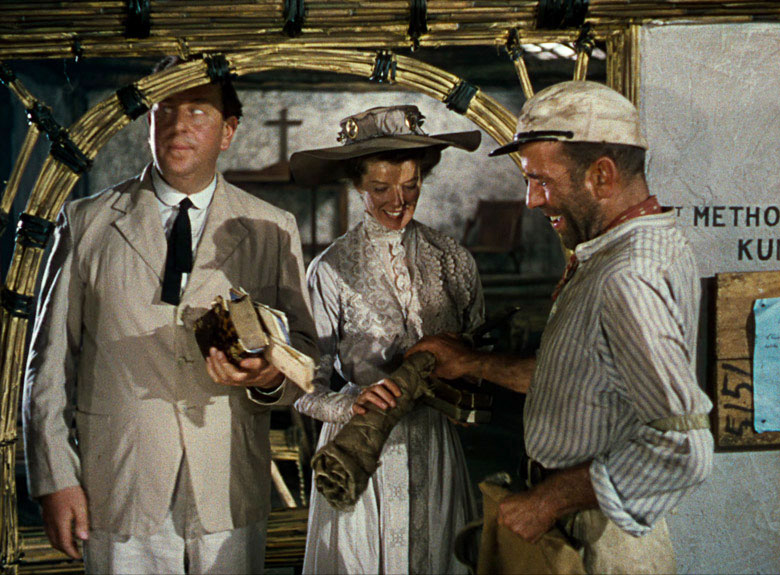
After armed Germans arrive setting alight to the entire village and enslaving the small population (could they be more utterly despicable?), the two missionaries can only witness the horrific destruction. As Samuel is struck down by a rifle butt, although not fatally wounded, you get the sense that he has already decided to die, such is his shock at the horrific barbarity before his eyes. He duly does pass on and his bereaved sister sits on the porch of their untouched dwelling suitably bereft. Re-enter Charlie with sound advice. The Germans will be back and that her brother Samuel needs to be under the ground soon. Dead bodies are not nasally acceptable in the tropical heat. Having had a mouse expire in the insulation of our cottage making one room uncomfortable because of the smell, I can sympathise. And so Charlie and Rose set off on a river bound adventure that both are initially reluctant about and then ambition sets in and Charlie suddenly finds himself with a force of nature on board... I will say one thing more about the plot and then leave those of you unfamiliar with the film to be charmed anew. Straitlaced and prim beyond a measurable scale, Rose is so far above Charlie socially and he knows it deferring left, right and centre to most of her whims. Charlie (in the novel a Cockney, here a Canadian), is doing his best but then Rose gets an idea of how they can practically fight back against the Germans and the enemy's powerful patrol boat that guards a very important stretch of river...
Despite the burly, muscled individual in the artwork pulling a more curvaceously rendered Hepburn from the jaws of hippos and crocodiles, Bogart was less of a strong-arm tough guy despite his more famous roles in crime noir. He's actually quite a slight actor, wiry and compact but hardly a heavy in the truest sense. But ineffable charisma can take you far. And he is playing powerfully against type here. He horses around playing the fool but once gripped by a powerful love for this odd, prim missionary, he will do anything for her. The fact that Bogart won his only Oscar for this performance makes me think that the Academy was more shocked having pigeonholed the actor for decades. It's thoroughly deserved. He's strong when he needs to be, vulnerable when cursed with ill luck and not only does he credibly clown around, he also plays the slurring drunk quite convincingly. You get the impression he had form in this area. Both Huston and Bogart were the only members of the cast and crew who didn't succumb to illness from infected drinking water. The drinking buddies never drank any. They survived on whisky! Hepburn, or so the extras tell us, was never far from a bucket while filming and not just the scenes in the church at the start. But apparently, she was a real trooper. Hepburn's presence on screen is very powerful. She always starts with a default "Impress me!" demeanour directed to people she first meets. Initially in the film she is guarded, then furious and mournful but she is ignited by her first experience of going down the rapids. Bogart has misread her completely hoping her exposure to these 'dangers' will put her off the insane plan the pair are putting into effect. No. She is lit up by the thrill as any sane person would be. But Africa has more than its fair share to throw at the couple as they attempt their impossible mission.
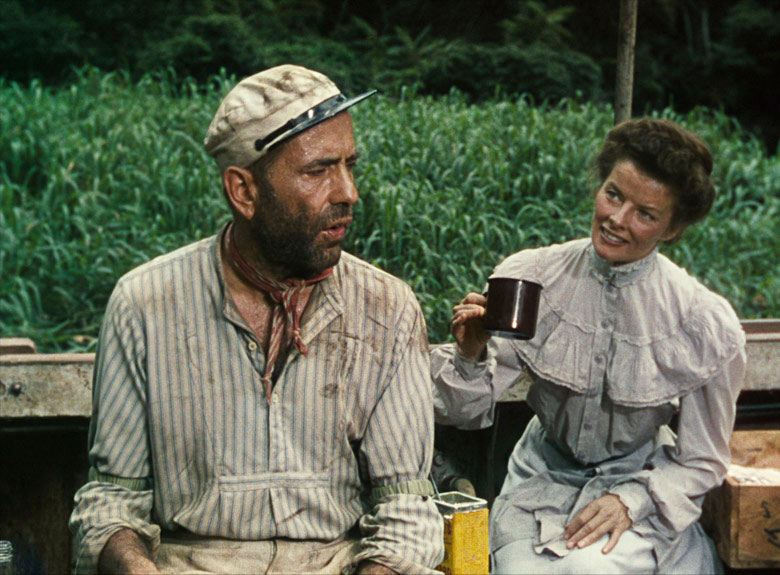
Today's audiences will easily spot the technical lapses and the sleight of film craft necessary to bring some scenes to life. No sane person jumps into a river in Africa unless they know more about bilharzia disease and crocodiles than Charlie Allnut. To that end, whenever we see the principals in the water, they are safely ensconced in the now defunct London studio of Isleworth. Also here were shot the more dangerous descents down the rapids. Give away back projection lines around the principals indicate that all the close ups were shot dry with stagehands throwing buckets of water at them. And models of the titular boat at enough of a low scale to present water unrealistically don't convince in 2019 and neither should they. If the model makers might have given their model Bogie some movement to be made out from a distance perhaps things would have been more believable. There's a microphone hastily removed from the bottom left of frame as salt is applied to the leeches on Bogie's shins (but to be honest, that's a researched goof which I didn't spot on my latest viewings).
There is also a wonderfully effective practical special effect sold by the ingenuity of the crew and the believability of the actors. It serves as one of the very first special effects I ever found about about as a hyper curious child starting his love affair with cinema. In author and critic John Brosnan's Movie Magic, a superb account of special effects way before digital watches let alone digital effects, he described effects man Cliff Richardson's answer to the problem of a swarm of mosquitoes the leads had to endure. Richardson tried the real thing in a sealed glass frame intended to go in front of the lens and then to be shot 'for real'. The uncooperative insects just sat on the bottom of the frame and wouldn't move. Then came the light bulb moment. What if water was poured into the glass box and tea leaves stirred vigorously before a take... Action! To present some historical balance, the cinematographer, the great Jack Cardiff, said the contents of this odd, narrow fish bowl were feathers. Feathers, tea leaves... Never mind. The effect works and has one aspect I'm dying to find out about but alas no one is alive that can inform me. The insects fade in over a single mid-shot of Bogie and Hepburn. If the effect were shot in camera for real, the 'mosquitoes' would have to have been 'on' the shot from the start. In this instance, they fade up as if shot separately and added in post. They also fade out in the middle of a mid shot strongly suggesting a post-production effect. There is no tell tale sign that these shots are further from the original negative (increased grain) so this is a mystery that will have to stay unanswered. Good. There are too few mysteries left in the world and especially too few in filmmaking.
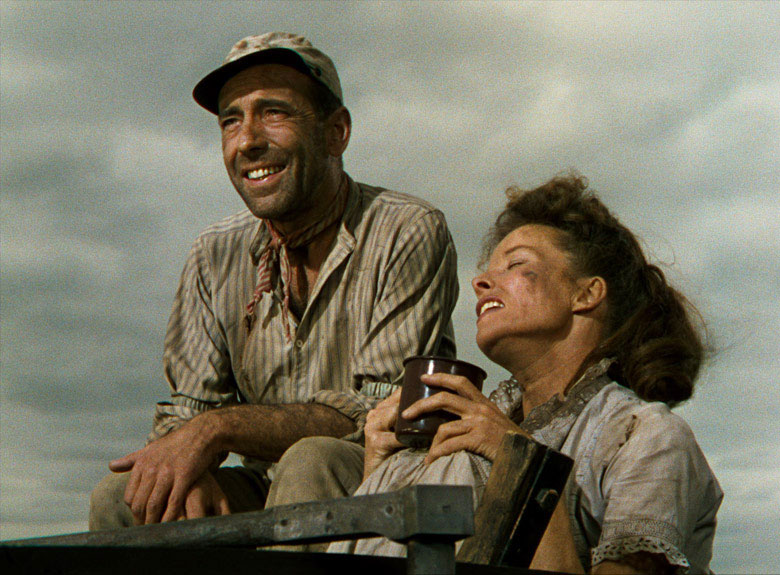
The African Queen is a product of its time and that time was sixty-eight years ago. But it stands up as a cracking romantic comedy with two stars at their highest wattage and a director whose passion is right up there on screen via Jack Cardiff's terrific three-strip Technicolor photography. Even though it was technically a British movie, it's a little bit of Hollywood history.
The 1.37:1 aspect ratio, 1080p presentation is clearly a Technicolor production and looks sumptuous. It's not quite as vibrantly colourful as I would have expected, but the film still oozes quality. When shot on location at magic hour, the film's vividness leaps off the screen. The contrast is even with very few black areas in frame and the 2009 BFI restoration (which I'm assuming was the basis of this presentation) is remarkably free from physical damage.
The uncompressed LPCM audio of the original mono soundtrack is perfectly fine with no problem understanding the dialogue and the music is faithfully reproduced with obviously no work for the sub to worry about.
There are optional English subtitles for the deaf and hard-of-hearing.
As is their nature, extra features take deep dives into the film and its production. In reviewing them, it’s possible that a few mild spoilers will be highlighted. Think of them as intriguing teases for the main feature.
Film Related (First Menu):
Together with playing the film are four options. (1) Without subtitles, (2) with English SDH subtitles (3) Isolated music & effects track. Knock yourself out. Still yet to find the reason anyone would want to play this for entertainment's sake but it takes all sorts. It's number (4) that's the real gem...
Audio commentary by cinematographer Jack Cardiff
"So simple!" So said John Huston. Not so says Jack Cardiff at the start of this brilliantly informative commentary. "It was horrendous!" I can well imagine it. Having worked in Africa, I have to commiserate with one aspect of the culture that I found so frustrating. There is a phone in the hotel room but it cannot be guaranteed to work. So if you ask if there is one, you have to be aware that what to you was implicit in that question is not always understood (that is; "...and does it work?") Kudos to Hepburn for her courageous nature. Bogie and Cardiff got on after a blessed first meeting. Cardiff perhaps wisely doesn't call attention to the first process shots (shot against a blue screen with background added later). Where the three actors gathered at the start of the film there was no river so the African Queen in the background was put on a track and slowly hauled forward. There's a lovely anecdote about Huston's practical jokes during the studio rain sequence and the tale about the necessary cross-dressing was a delight. There are large chunks where Cardiff is quiet (mostly over the studio filming) but he comes back in while our heroes are prepping the torpedoes. I have a lot of time for Cardiff's contribution to cinema over all so always have a good time with his commentaries and interviews.
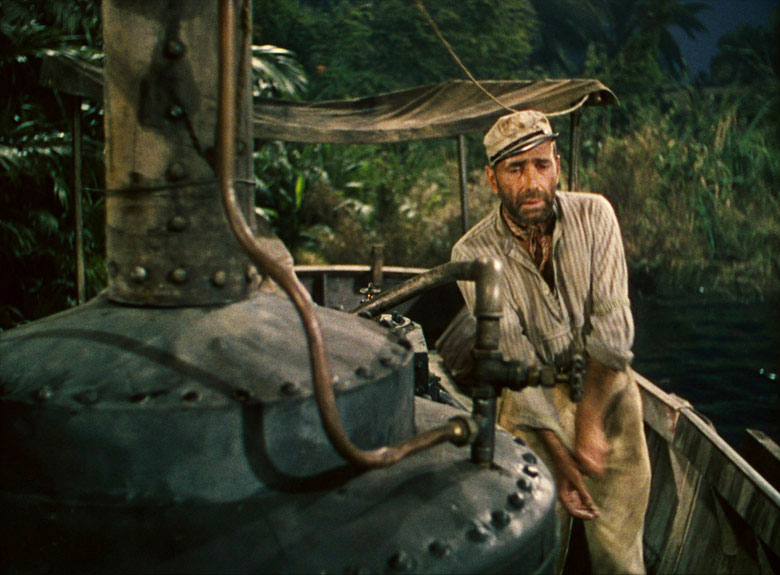
Stand Alone Special Features (Second Menu):
New video interview with historian Neil Sinyard (15' 55")
Sinyard's take is as ever informative and full of lovely associations that only such an eclectic and inquisitive mind (armed with the memory of several herds of pachyderms) could conjure up. I'd love to know his workflow for these extras but like an extra itself, what if it destroys the magic of having a man talk entertainingly about the film without recourse to notes and so few cuts. He covers the film and especially the casting. He goes deeply into the stories of the making of the film. Director Huston was disillusioned with Hollywood and McCarthyism and was happy to get away to a very remote location to direct a few firsts in his career – a film in colour, a romantic comedy and a love story. Sinyard reminds us that this is essentially "two old people going down a river in a boat." Ah, but what two people. Bogart and Hepburn is a classic pairing, both actors adorned with significant Hollywood baggage and both manage to play against type. He reminds us that the story has its absurdities and the film plays up to these as strengths. He underlines my favourite aspect of the film... White water, as mentioned earlier, can bring out the adventurer in you. It's another lovely informative extra from our hugely knowledgeable star of the Blu-ray extra features.
New video interview with critic Kim Newman (18' 46")
Newman's first insight is one I've brought up before on the site's pages. I suggested that 'method' actors make life difficult for themselves not to get under the skin of their character but to absolve themselves from living an easy life by pretending to be someone else in front of several layers of glass (best not to mention the silly money and the pampering). Newman's idea is that the 'effete' job of filmmaking was enjoyed by an over-privileged few who were handsomely rewarded for a life of preferential treatment. John Huston could make a claim to be at the vanguard of the machismo film director, the ones who want to make their filmmaking experience unreasonably difficult and fraught so they can at least feel they've done a difficult job. Let's stack a bit more irony on that. Directing is not a simple job but neither is it gruelling unless there are six of you. If you have a full crew, the director doesn't exactly break a sweat in manual work. In fact during a take, Huston was quietly fishing off the back of the filming boat with his back to the actors. Hepburn not unreasonably called 'Cut!' in defiance of her director's behaviour. Newman also reminds us that Huston – the very epitome of the Hollywood director – made niche, idiosyncratic art movies. It just so happens that his only romantic comedy (that's a bit of a stretch for a genre definition) was his biggest hit. He reminds us that even Humphrey Bogart "suffered from the illusion that he was Humphrey Bogart," which must be the greatest wish and worst curse ever to befall any actor. I love Newman's reading of Bogart and Hepburn being Hollywood's first suicide bombers! This is another excellent extra with one of the industry's most informed critics.
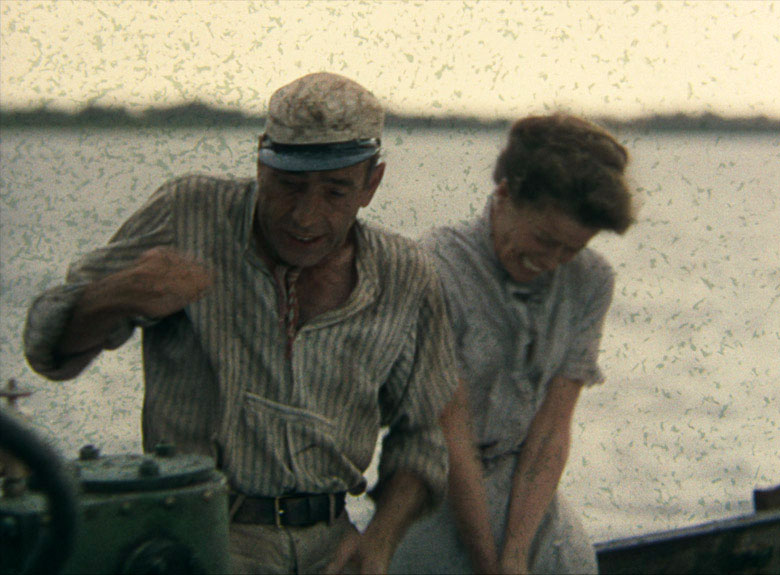
A video interview with co-screenwriter Peter Viertel, author of White Hunter, Black Heart, by filmmaker Michael Scheingraber (17' 42")
Gravel-voiced and someone you can well imagine John Huston would call a friend, Viertel gives us an insider's look at the start of production from the writer's perspective. This extra is taken from 400 hours of interview shot by filmmaker Michael Scheingraber shortly before Vietrel died in 2007. His memories are most welcome. Huston said a rewrite would be done in two weeks. Viertel knew from the start this was wild and wishful thinking. His pronunciation of 'sadism' as SAD-ism (as in feeling 'sad') has given me a whole new perspective on the word, one that he naturally applied to Huston. His accent is damn well flawless and not for a moment (until 'sadism') did I think he was anything but a native English speaker. He is, as his name suggests, German. Again, praise is heaped on the stoicism and endurance of Katherine Hepburn. Huston's personality (nicknamed 'the monster' in the location village) could of course, like most directors, be charm personified. Viertel let Huston read the book he's most famous for, White Hunter, Black Heart and though Huston liked it, he got Vietrel to change the ending. There's a lovely irony that on filming it, Clint Eastwood changed the ending again. It was a love letter to a friend almost completely misunderstood by critics who through Viertel had 'shot him in the back.' This is a fascinating glimpse into classic 50s Hollywood and it's worth reading up on this man as he had a wonderful career and as an odd fact, his personality and looks were the basis of the Robert Redford character in The Way We Were. Take some time to process that. But it's a lovely extra feature.
Audio recording of the Guardian interview with John Huston at the National Film Theatre in 1981, discussing his work and career (1 hour 29' 13")
We start at the very beginning (cue Sound of Music lyric) and the inimitable sound of John Huston. He takes us on a biographical journey for the first thirty minutes and we break into audience questions quite early. The questions, as ever with these extras, are on the very edge of audibility and the interview takes a bit of dip in energy at this point but Huston wasn't a showman for no reason and soon gets us back on track. To me, Huston will always be the truly nasty piece of work that was Noah Cross in Chinatown. To the rest of the film world, Huston's Hollywood legacy is assured. A fascinating man with an amazing oeuvre, he's one of the very few 'star' directors who defined in the public eye what a director actually was.
Some nuggets stand out; down and out and sleeping rough in London, he used to beg by singing cowboy songs to the public. He notes that the director is often seen as the 'father' by a film crew. When directing his own father Walter, he noted somewhat wryly that not only was he the father of his father but that this made him his own grandfather. Directing Clark Gable he realised that he just had to let Gable be Gable for he wasn't capable of 'acting' in the traditional sense. That is the very definition of being a star, I guess. Upon showing some of the African elders their work on the film, the tribesmen announced that "We shall never die!" How right they were. Huston feels that his work is often pored over by critics too deeply. He claims to understand very little of critics' assessments of what he was actually communicating in his work. When asked why he cast his daughter in one of his films, he brazenly replies that it was "...to further the career of my daughter!" The day before a general election that will redefine my native land for the rest of my life at the very least, I miss that kind of honesty in public discourse. Bless you, John Huston.

Audio recording of an on-stage NFT discussion about the film with Anjelica Huston and script supervisor Angela Allen from 2010 (30' 53")
With infrequently changing front of house stills as a visual element, this extra provides great stories from the woman at the very centre of the shoot, Angela Allen, whose bravery (taking notes from a canoe three feet from a hippo) was one of the reasons Huston worked with her so often. They had just seen a restoration of the film and director's daughter Anjelica Huston is on hand to add her personal stories of her father. If anything, the interview is quite short (I'd have been asking loads of questions so thankfully for the audience's sake, I wasn't there). The anecdotes are mostly witty and director Huston is the pivotal figure of most of them. The first audience member to bring up a question waits for the microphone and yes, is that BBC DJ Paul Gambaccini with the first question? There is no bad language or violence in The African Queen, something Allen champions. She then notes her distaste for what she calls British "F & C films!" Am fairly sure I know what the 'F' stands for...
Technically, the tiny misstep of this interview is that the interviewer Adrian Wootton is foregrounded microphone-wise while the guests are recorded at a lesser volume. This means that anything humourous gets an explosive laugh that is quite piercingly loud. Otherwise, this is a lovely extra told from an often overlooked perspective which Blu-ray makers should take advantage of. Script supervisors unite!
Embracing Chaos: Making The African Queen, a comprehensive documentary about the making of the film (59' 20")
After some charming actuality of Bogart and Bacall interviewed casually, we enter into a Ken Burns zoom-fest of frightening rapidity. Thankfully that was just the opening. This is, as it says on the tin, a comprehensive and extremely entertaining look at all the detail that preceded, accompanied and followed the making of The African Queen. The contributors are legion. Lovely to see Nicholas Meyer waxing enthusiastic about the film. I didn't realise he produced this Paramount production in 2010. If he was shot at his residence, he has a London Underground tube map framed above the fireplace. I have to say, I share his conviction that this map is a work of art. It's certainly a work of fiction but that's its genius. Martin Scorsese is a frequent contributor as is assistant director Guy Hamilton. You may not be that familiar with that name but his role in shaping pop culture cannot be underestimated. Here is a short list of his directing credits... Goldfinger. Told you it was short but pretty sure Goldfinger is enough to be going on with. Huston's hunting ambitions are underlined and the fact that the crew found itself in the middle of a leper colony. I have no other trigger for that much-maligned word other than Steve McQueen taking a sip of coffee in which floats a human finger in Papillon. "How did you know my leprosy isn't contagious?" "I didn't," the hero replies... This is a solid hour of African Queen trivia and celebration and is a great extra feature of this disc.

Lux Radio Theater adaptation from 1952 with Humphrey Bogart and Greer Garson (59' 23")
Greer Garson takes the Hepburn role in this audio reimagining of the film. The entertainment of the piece is usually the truly dreadful soap commercials at the front, middle(s) and end of the programme and they don't disappoint. The best (as in the best example of how bad these commercials can be) can be heard at 34' 12". "I just returned from Paris..." coos Zsa Zsa Gabor. There follows a painfully scripted scene of stilted banter that no sentient human being could take seriously. The oleaginous host plants his tongue where even Lux dares not go and says the following which today would ensure his cellmate was Harvey Weinstein; "...with that creamy complexion of yours. It's a Lux complexion, I know." God, I know it's a time capsule and all that but it is still staggering. "Be Lux lovely for the holidays ahead!" Aieeee. The live audience provides another level of enjoyment. I think I must have smiled at the following; "I pronounce you man and wife... Proceed with the execution!" but live, this gets a belly laugh. The drama finishes at 52' 47" and as you can see from the running time, that means almost seven more minutes of Lux commercials and scripted interview with the stars to play us out. Heaven help us.
Original theatrical trailer (2' 42")
"Never before, has the screen combined such talent and artistry," says the big yellow letters and both Bogart and Hepburn plunge into the rapids in their model boat. This is a standard issue trailer with clips from dramatic moments and a fair few, if mild, spoilers. Just as the title comes up at the close, we cut in to a circular superimposition of Hepburn saying in close up (with a clumsy cut midway) "I never dreamed that any experience could be so stimulating!" Of course, the more risqué full dialogue line from the movie was "I never dreamed that any mere, physical experience could be so stimulating!" Rosie Sayer needs to get out more. While the trailer finishes at 2' 25", the final 17" shows 'The Picturegoers Seal of Merit' certificate awarded for outstanding craftsmanship. Fair enough. "If you got it baby, flaunt it!"
PLUS: A LIMITED EDITION 60-PAGE Perfect Bound Collector s book featuring archival writing on the film
A PAIR OF ACES AND A QUEEN
– The Picturegoer (vol. 23, no. 879 – 8 Mar 1952)
It’s interesting to note that The Picturegoer was a monthly British publication and not quite the fawning press puff rag as I had imagined. My apologies to history. David Marlowe and Sally Sutherland’s article about the making of the film is both entertaining and illuminating. The former’s curiosity about Huston the man as opposed to Huston the legend is quite revealing. The latter writer is more concerned with Hepburn and two priceless moments of humour on the shoot. She also describe Hepburn’s meteoric rise in stage work. There’s a real nugget of wisdom in Hepburn’s recollections. Imagine being the fiftieth actress to read a scene knowing those who hold the power to cast were those driven to madness by the boredom of hearing it repeated over and over. Hepburn demanded a new scene. She got it and the part. Is it me or is it a little bit odd to have a full page picture of Bogey’s partner to accompany the article? And when I say Bogey’s partner I mean, of course, Lauren Bacall… not Hepburn.
AFRICAN ADVENTURE
– The Veteran Magazine (Spring 2003)
Teddy Joseph’s African memoir working as the location manager is a terrific read published in 2003. Having worked in Africa myself, there are many stories which ring true, sometimes beautifully and sometimes horribly. He seems to have quite a clear picture of events and I’m really happy to report that up until now, there has been such little repetition with the other extras that these articles really must be considered quite the find.
INTERVIEW WITH JOHN HUSTON
by Karel Reisz (Sight and Sound - vol. 21, no. 3 – Jan/Mar 1952)
This contemporary 1952 interview by soon to be filmmaker Karel Reisz is another great find. First I must call attention to the enormous three-strip Technicolor camera in the photo opposite the article’s opening page. The size of it never ceases to stun me. It’s like a giant fridge and probably just as heavy. Fascinating to hear from Huston that if the film is written and cast right, direction is something of a perfunctory discipline. Let the actors inhabit their roles as best they see fit and just shoot them!
EXTRACTS FROM “THE MAKING OF THE AFRICAN QUEEN” by Katharine Hepburn (1987)
This is the book that is mentioned a lot and by all accounts in the extras, Hepburn’s book contains a few exaggerations but then what great stories don’t? Let’s have a look. I love it already from the quote “There was no bunk about Bogey. He was a man.” We live in strange times but that simple three-letter word is full to the brim with adjectives, all positive and all in service of an actor who seemed to really care. Hepburn was bowled over. She talks about the moment Huston gave her “…the best goddamnedest best piece of direction I ever heard.” And the extracts close with Oscar night. I think I really must buy the book now. Lovely.
PETER VIERTEL: IN MEMORIAM
by Michael Scheingraber (2019)
Writer Peter Viertel’s life reads like a boy’s own fantasy. He ran spies against the Nazis (he was German remember, just imagine what they would have one with him if caught). He introduced surfing (!) to Europe in the 50s and he was 21 (21!) when he wrote Saboteur for Alfred Hitchcock. Wow. This is a glorious obituary for one of the most extraordinary of men.
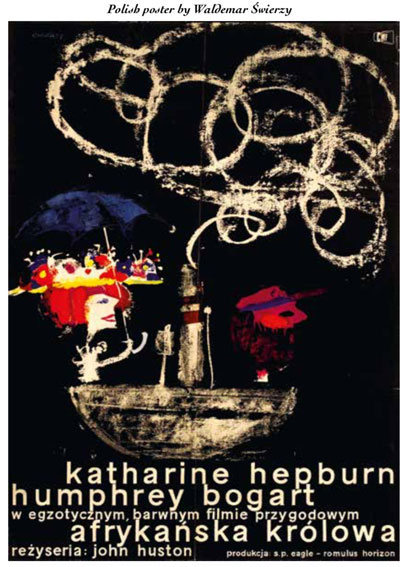
ARTWORK
Of the eight posters and advertising materials guess which country produces the most interesting if completely out to lunch poster of the lot. Yup, it’s Poland again. The Polish poster is surreal and has to be seen to be believed.
This is a great booklet with very little overlap of information, always a big plus.
The African Queen is a Hollywood classic and no amount of retroactive criticism is going to dent that reputation (at least not in this decade – he says twenty odd days away from 2020). I'm fearful of a time when history buckles and cracks from the terrifying weight of today's justice retroactively applied. That's a battle for another day. The Bogart Hepburn double hander is a delight and it's a bona fide classic movie that still holds up today. Warmly recommended.
|